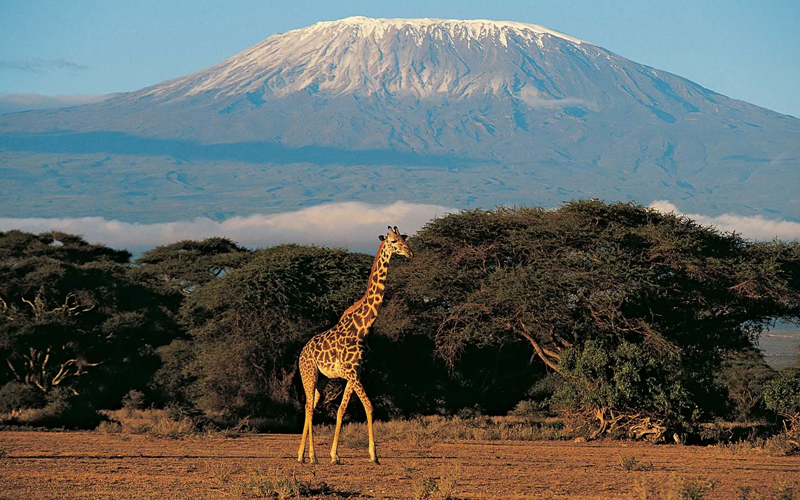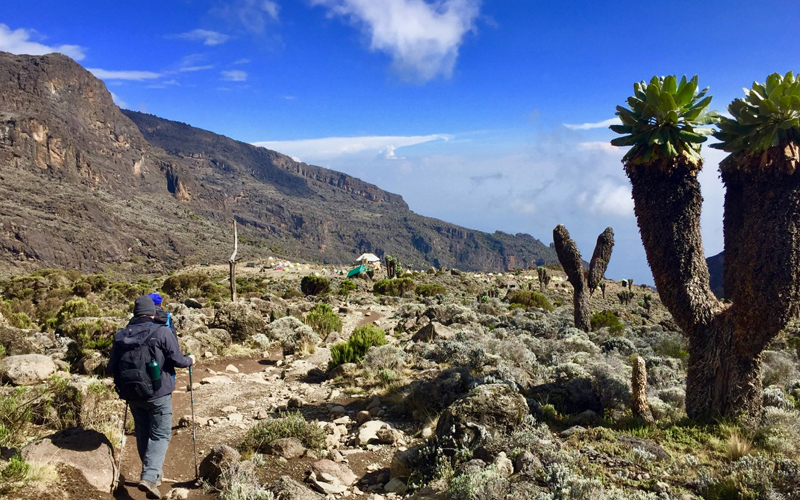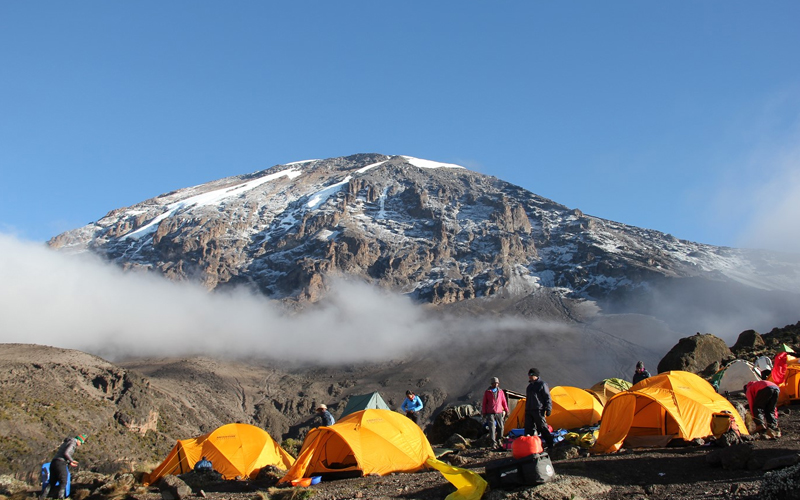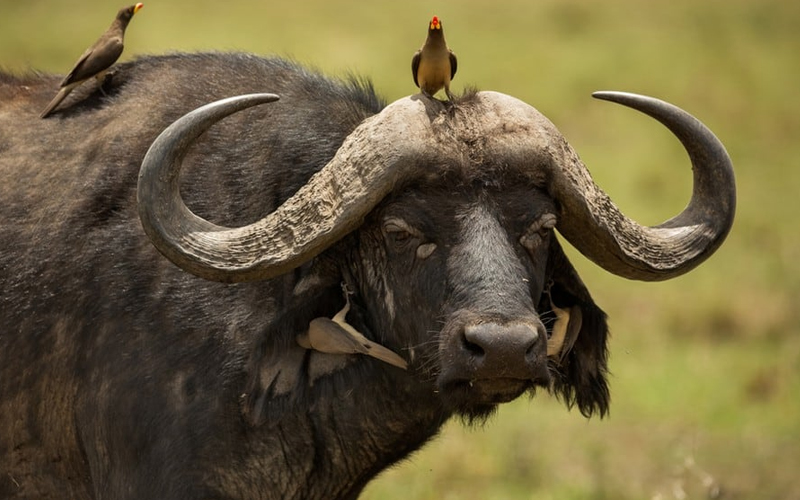Tanzania’s diverse landscapes and breathtaking scenery make it a paradise for hiking enthusiasts seeking adventure in the great outdoors. From towering mountains and lush forests to rolling hills and vast plains, Tanzania offers a multitude of hiking trails that cater to all levels of experience and fitness. Whether scaling the heights of Mount Kilimanjaro, exploring the crater rim of Mount Meru, or trekking through the Ngorongoro Highlands, hikers in Tanzania are treated to awe-inspiring vistas, unique wildlife encounters, and unforgettable experiences in nature.
Tanzania’s Natural Wonders
- Mount Kilimanjaro: Mount Kilimanjaro, Africa’s highest peak, is a bucket-list destination for hikers from around the world. Rising majestically above the East African plains, Kilimanjaro offers a range of hiking routes that lead climbers through diverse ecosystems, from lush rainforests to alpine deserts. The summit of Uhuru Peak stands at 5,895 meters (19,341 feet) above sea level, offering panoramic views of the surrounding landscape and the opportunity to watch the sunrise from the “Roof of Africa.”
- Mount Meru: Mount Meru, Tanzania’s second-highest peak, is a lesser-known but equally rewarding hiking destination. Located within Arusha National Park, Mount Meru offers a challenging ascent to its 4,566-meter (14,980-foot) summit, passing through montane forests, alpine meadows, and rugged volcanic terrain. The summit crater affords hikers stunning views of Mount Kilimanjaro and the surrounding plains, making it a popular choice for those seeking a high-altitude adventure with fewer crowds.
- Ngorongoro Highlands: The Ngorongoro Highlands, a UNESCO World Heritage Site, is a picturesque region renowned for its scenic beauty and rich biodiversity. Hiking trails in the Ngorongoro Highlands traverse lush forests, rolling hills, and verdant valleys, offering hikers the chance to explore the area’s unique ecosystems and encounter a variety of wildlife, including elephants, buffaloes, and endemic bird species. The Empakaai Crater Trail is a highlight, leading hikers to the rim of a dormant volcanic crater with a scenic lake at its center.
Top Hiking Trails
- Machame Route (Mount Kilimanjaro): The Machame Route, also known as the “Whiskey Route,” is one of the most popular and scenic trails up Mount Kilimanjaro. The route traverses diverse landscapes, including lush rainforests, moorlands, and alpine deserts, before reaching the summit via the southern slopes. Hikers on the Machame Route enjoy breathtaking views of Kilimanjaro’s glaciers and surrounding scenery, making it a favorite among adventurous trekkers.
- Lemosho Route (Mount Kilimanjaro): The Lemosho Route is a longer and more remote option for climbing Mount Kilimanjaro, offering hikers a quieter and more pristine wilderness experience. The route approaches the mountain from the west, traversing untouched forests and high-altitude moorlands before converging with the Machame Route near the summit. The Lemosho Route is renowned for its stunning panoramas and abundant wildlife, including sightings of colobus monkeys and other endemic species.
- Mount Meru Summit Trail: The Mount Meru Summit Trail is a challenging but rewarding hike that leads hikers to the summit of Tanzania’s second-highest peak. The trail begins in Arusha National Park and ascends through dense forests, open grasslands, and rocky slopes to reach the summit crater. Along the way, hikers encounter diverse flora and fauna, including black-and-white colobus monkeys, giraffes, and buffalo herds, making it a wildlife-rich hiking experience.
- Empakaai Crater Trail (Ngorongoro Highlands): The Empakaai Crater Trail offers hikers the opportunity to explore the stunning landscapes of the Ngorongoro Highlands and discover the beauty of a volcanic crater lake. The trail begins near the Ngorongoro Conservation Area and descends into the crater, passing through lush forests and grassy plains along the way. Hikers are rewarded with panoramic views of the crater lake and surrounding scenery, as well as the chance to spot flamingos and other birdlife around the water’s edge.
Hiking Experience
- Difficulty Levels and Fitness Requirements: Hiking trails in Tanzania vary in difficulty and terrain, with some routes suitable for beginners and others requiring a higher level of fitness and experience. Mount Kilimanjaro’s summit trails, for example, are challenging due to the high altitude and steep ascents, requiring hikers to be in good physical condition and acclimatize properly. On the other hand, shorter day hikes in the Ngorongoro Highlands are more accessible to hikers of all levels, offering a taste of Tanzania’s natural beauty without the need for extensive preparation.
- Guided Tours and Porters: Many hikers opt to join guided tours or hire local porters and guides to assist them on their hiking adventures in Tanzania. Guided tours provide hikers with experienced leaders who know the trails, terrain, and weather conditions, ensuring a safe and enjoyable experience. Porters are invaluable for carrying gear, setting up camp, and providing support along the way, allowing hikers to focus on enjoying the journey and soaking in the scenery.
Safety Tips
- Altitude Sickness Prevention: Altitude sickness, also known as acute mountain sickness (AMS), can affect hikers ascending to high altitudes, such as those on Mount Kilimanjaro and Mount Meru. Symptoms of altitude sickness may include headache, nausea, dizziness, and fatigue, and can be severe in some cases. To prevent altitude sickness, hikers should acclimatize properly by ascending gradually, staying hydrated, and listening to their bodies for signs of distress. It’s essential to inform guides or fellow hikers if experiencing any symptoms of altitude sickness.
- Weather Conditions: Weather conditions in Tanzania’s mountainous regions can be unpredictable, with temperatures varying widely depending on the altitude and time of year. Hikers should be prepared for sudden changes in weather, including rain, wind, and cold temperatures, by dressing in layers and packing appropriate gear such as waterproof clothing, sturdy hiking boots, and insulated sleeping bags. It’s advisable to check weather forecasts and trail conditions before embarking on a hike and to follow the guidance of experienced guides and park rangers.
Best Time to Hike
- Seasonal Highlights
The best time to hike in Tanzania depends on the destination and the preferences of the hiker. Generally, the dry season, from June to October, offers favorable hiking conditions with clear skies, mild temperatures, and minimal rainfall, making it an ideal time for summiting Mount Kilimanjaro and exploring the Ngorongoro Highlands. The wet season, from November to May, brings lush green landscapes and fewer crowds but also increased precipitation and muddy trails, requiring extra caution and preparation for hiking adventures.
Camping and Accommodation
- Mountain Huts and Campsites: Hikers on multi-day treks in Tanzania often camp overnight at designated campsites or mountain huts along the trail. These facilities provide basic amenities such as shelters, toilets, and cooking areas, allowing hikers to rest and recharge after a day of hiking. Camping under the stars amidst Tanzania’s scenic landscapes offers a unique and immersive wilderness experience, with the sounds of nature as the only soundtrack.
- Lodge Accommodation: For those seeking more comfort and convenience, lodge accommodation is available at some hiking destinations in Tanzania, offering comfortable rooms, hot showers, and hearty meals at the end of a long day on the trail. Lodges like Miriakamba Hut on Mount Meru and Simba Camp on Mount Kilimanjaro provide hikers with a cozy retreat and warm hospitality, allowing them to relax and rejuvenate before continuing their hiking adventures.
Culinary Delights
- Trail Snacks and Meals: Hiking in Tanzania requires fueling the body with nutritious snacks and meals to sustain energy levels throughout the journey. Trail snacks such as energy bars, nuts, dried fruit, and trail mix are lightweight and portable options for on-the-go nourishment, while hearty meals cooked over a campfire or portable stove provide hikers with essential nutrients and comfort after a day of hiking. It’s essential to pack plenty of water and electrolyte-rich beverages to stay hydrated and replenish lost fluids while hiking in Tanzania’s mountainous terrain.
- Cultural Dining Experiences: In addition to trail food, hikers in Tanzania can indulge in cultural dining experiences that showcase the region’s diverse culinary traditions and flavors. Many lodges and campsites offer meals prepared with locally sourced ingredients, such as fresh produce, meats, and spices, allowing hikers to sample authentic Tanzanian cuisine in a scenic outdoor setting. Dining under the stars with fellow hikers and local guides provides an opportunity to share stories, forge friendships, and savor the simple pleasures of a shared meal in nature.
Wildlife Encounters
- Unique Fauna and Flora: Hiking trails in Tanzania offer hikers the chance to encounter a diverse array of wildlife, from iconic big game species to rare and endemic flora and fauna. Mount Kilimanjaro and Mount Meru are home to a variety of wildlife, including elephants, buffalo, antelope, and monkeys, as well as unique plant species adapted to high-altitude environments. Hikers may also encounter birds of prey, reptiles, and insects along the trails, adding to the rich tapestry of Tanzania’s natural heritage.
- Conservation Efforts: Tanzania is committed to preserving its natural heritage and protecting its wildlife and ecosystems for future generations to enjoy. National parks and conservation areas play a crucial role in safeguarding Tanzania’s biodiversity, with measures in place to minimize human impact, prevent poaching, and promote sustainable tourism practices. Hikers can support conservation efforts by respecting park regulations, staying on designated trails, and minimizing their environmental footprint while enjoying Tanzania’s natural wonders.
Cultural Immersion
- Local Communities: Exploring Tanzania’s hiking trails allows hikers to engage with local communities and learn about the cultural heritage and traditions of the region. Many hiking routes pass through villages and rural settlements, where hikers can interact with local residents, learn about traditional lifestyles, and participate in cultural activities such as dancing, drumming, and storytelling. Engaging with local communities provides hikers with insights into Tanzania’s rich cultural diversity and fosters cross-cultural understanding and appreciation.
- Cultural Experiences: Tanzania’s hiking trails offer opportunities for cultural immersion and experiential learning, allowing hikers to gain a deeper understanding of the region’s history, customs, and traditions. Guided tours and cultural experiences may include visits to Maasai villages, where hikers can learn about traditional Maasai culture and customs, participate in tribal ceremonies, and purchase handmade crafts and souvenirs. Cultural immersion adds depth and meaning to the hiking experience, enriching the journey with insights into Tanzania’s vibrant cultural tapestry.
Environmental Conservation
- Leave No Trace Principles: Hikers in Tanzania are encouraged to adhere to the principles of Leave No Trace, a set of outdoor ethics designed to minimize human impact on the environment and preserve the natural beauty of wilderness areas. Leave No Trace principles include packing out all trash, staying on designated trails, minimizing campfire impacts, and respecting wildlife and natural habitats. By practicing Leave No Trace ethics, hikers can help protect Tanzania’s hiking trails and ensure that future generations can enjoy them for years to come.
- Sustainable Practices: Sustainable hiking practices are essential for minimizing the environmental impact of hiking activities in Tanzania. Hikers can reduce their carbon footprint by choosing eco-friendly transportation options, such as public buses or shared shuttles, to access trailheads and minimize waste by using reusable water bottles and containers. Supporting local businesses and community initiatives, such as buying locally sourced products and contributing to conservation programs, helps promote sustainable tourism and economic development in Tanzania’s rural areas.
Hiking in Tanzania offers an unparalleled opportunity to explore the natural beauty, cultural heritage, and wildlife diversity of this East African gem. From the snow-capped peaks of Mount Kilimanjaro to the verdant valleys of the Ngorongoro Highlands, Tanzania’s hiking trails lead adventurers on a journey of discovery, challenge, and awe-inspiring beauty. With its commitment to environmental conservation, cultural preservation, and sustainable tourism, Tanzania invites hikers to embark on an unforgettable outdoor adventure and connect with nature in its purest form.
FAQs
How long does it take to hike Mount Kilimanjaro?
The duration of a Mount Kilimanjaro hike depends on the chosen route and itinerary. Most climbers opt for multi-day treks ranging from five to nine days, allowing time for acclimatization and summit attempts. The Machame and Lemosho Routes are typically completed in six to eight days, while the Marangu Route can be completed in five to six days.
Do I need a permit to hike in Tanzania?
Yes, hikers need permits to access Tanzania’s national parks and conservation areas, including Mount Kilimanjaro, Mount Meru, and the Ngorongoro Highlands. Permits are required for entry, camping, and hiking activities and can be obtained through authorized tour operators or park authorities.
What is the best time of year to hike in Tanzania?
The best time to hike in Tanzania depends on the destination and the preferences of the hiker. Generally, the dry season, from June to October, offers favorable hiking conditions with clear skies, mild temperatures, and minimal rainfall, making it an ideal time for summiting Mount Kilimanjaro and exploring the Ngorongoro Highlands.
Are there age restrictions for hiking trails in Tanzania?
Age restrictions for hiking trails in Tanzania may vary depending on the destination and difficulty level of the trail. While many hiking routes are suitable for hikers of all ages, certain trails, such as those on Mount Kilimanjaro, require a minimum age and level of fitness due to the challenging terrain and high altitude.
What should I pack for a hiking trip in Tanzania?
Hikers in Tanzania should pack essential gear and equipment for their hiking adventures, including sturdy hiking boots, weather-appropriate clothing, a backpack, water bottles or hydration system, sunscreen, insect repellent, a first-aid kit, and a camera or smartphone for capturing memories along the trail. It’s essential to pack light but adequately to ensure comfort and safety while hiking in Tanzania’s diverse landscapes.





